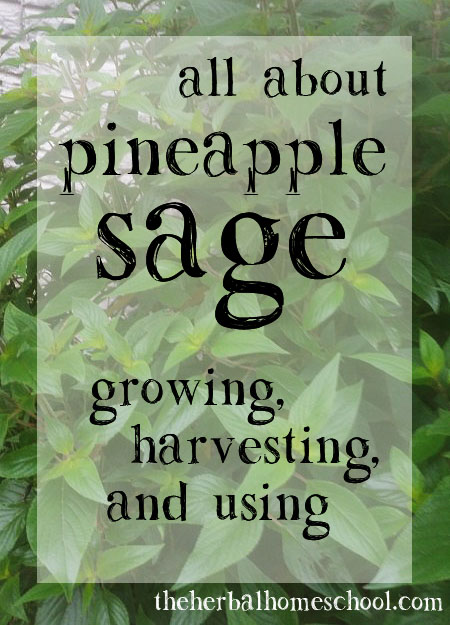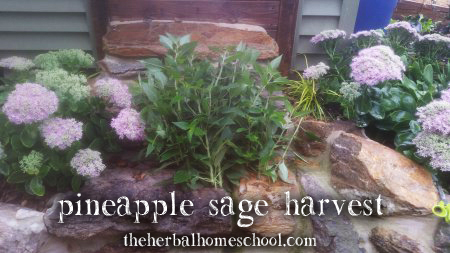Pineapple Sage; Growing, Harvesting, and Using

Wondering how to use your Pineapple Sage in your cooking? Eager to add this beautiful, fragrant herb to your garden? Keep reading! I’ve had Pineapple Sage growing in my garden for years. I love the amazing aroma, how enthusiastically it grows, the lovely tropical red flowers it’s produced even in a colder climate!
Growing Pineapple Sage
This fragrant herb is native to Central & Southern America and is considered a tender Perennial here in North America. This meaning that it will happily overwinter in warmer climates, but needs to either be brought inside to overwinter, babied by planting strategically & mulching, or grown as an annual in colder climates. I am going to try to grow some pineapple sage from seeds this spring in an effort to make my garden more more cost efficient
Here in zone 7/6b I have found that it grows very enthusiastically as a perennial with minimum TLC. Gardeningknowhow.com says, “Pineapple sage grows rapidly in a location with morning sun and afternoon shade. Those in more Northern zones may plant in a protected location, mulch in winter and experience perennial performance from the pineapple sage plant.”
Since we live on a cold, windy hill, I have it growing against a concrete wall on the south side of our house. This blocks any wind that might strip the leaves off and provides some extra radiant heat from the concrete wall. Here it reaches 4-5 feet tall, but in less suitable climates or in a pot it will not grow as high.
Consider planting this in an area you frequent because it releases a glorious Pineapple scent when you brush against it and produces beautiful tropical red flowers that are also edible. If you just can’t get enough Pineapple Sage, most gardeners say that this is best propagated from cuttings.
How to harvest Pineapple Sage

I used some scissors to trim back my Pineapple Sage bush a few feet on each side and ended up with a huge armful of sage. I also ended up with an armful of creepy bright green beetles that were covering my plant. I learned my lesson quickly and left the sage out on the porch instead of bringing all the bugs in the house. To harvest, I had my toddlers help me pick the leaves off the branches and put them in a strainer then rinsed them off. I dehydrated the clean pineapple sage leaves in my Excalibur dehydrator overnight and have them stored in Mason Jars in my pantry. Some sites claim that it’s flavor intensifies as it dries and others claim that drying it makes it lose its fruity flavor. I guess I will have to experiment with it.
What to Use Pineapple Sage for?
I found many relatively similar ideas for using Pineapple Sage when I searched online, so I have distilled the many ideas into some guidelines to give you some inspiration when you are up to your knees in sage leaves. Pineapple Sage is a relatively mild herb, so I would suggest using it larger quantities than you would use other more potent herbs.
- Using Herbs in Cooking; intro
- How to make time to enjoy hobbies
- 6 Guidelines to Using Herbs During Pregnancy
Cooking with Pineapple Sage
– As a general rule, Pineapple Sage is best in light and fruity things. It makes an excellent addition to desserts such as ice cream and fruit salads.
– Pineapple Sage can be used as a flavoring for chicken, pork, and fish. I made a delicious Pineapple Chicken using frozen pineapple, pineapple sage, Turmeric, a bit of maple syrup, and sautéed onions as a counterpoint. My husband was skeptical at first, but the first bite had him convinced! I did not find anyone else using this more delicate herb for red meat, and just can’t picture Pineapple flavored venison, so I believe I will be skipping that and sticking with the white meat when getting my Pineapple Sage fix!
Here are a few seasoning combinations that I have come up with for your enjoyment and mine;
- Pineapple Sage, garlic, and lemon flavoring (this could include lemongrass, lemon juice, lemon zest, etc.)
- Pineapple Sage, Pineapple chunks, maple syrup, and onion
- Pineapple Sage, paprika, and a pinch of salt
- Pineapple Sage, orange zest, and green onion (you could also add a hint of ginger)

–Pineapple Sage can be added to cream cheese. Let me know if you try this one; I am very allergic to dairy products and will not be doing this myself, but I would love to hear your experience!

– Make herbal sugar; layer leaves in sugar & let them sit to infuse them with the flavor. I did this & it definitely has a fruity aroma. I need to test it on my husband and see if he notices anything different or likes it more than the plain sugar.
– Some sites suggested using Pineapple Sage as an addition to syrups. We make a delicious Goumi berry syrup to use for our special family breakfasts that pineapple sage could be an excellent addition to. Some folks also suggested making it into jelly. Since I am not looking to get more sugar into our diet (the opposite actually!) so I won’t be doing this, but it could be a good option if you enjoy more delicate jellies.

– In Drinks: Pineapple Sage can also be included in herbal teas and summery drinks; it pairs well with mint and lime flavors. As an added benefit, pineapple sage is also cooling to the body (ayurtimes.com) making it a perfect addition to a cold summertime treat!
Using Pineapple Sage Medicinally
Medicinally, Pineapple Sage has been used to treat indigestion and heartburn. A 2009 study suggests that common sage may assist in the digestion of meat products. Traditional Mexican medicine also uses Pineapple Sage to treat anxiety, depression, and level out blood sugar. (ramblingtart.com)
Ayur Times suggest the following dosage when using Pineapple Sage medicinally:
- Fresh Pineapple Sage Leaves; 3-5 grams
- Dried Pineapple Sage Leaves; 1-3 grams
- Fresh Pineapple Sage Flowers; 2-5 grams
- Dried Pineapple Sage Flowers; 1-3 grams
And there you have it; some fun and healthy ideas to make your cooking more exciting and your garden more productive & beautiful! If you enjoyed this, check out these other posts as well!
- All About Ginger: Benefits, Doses, Growing Tips, and Recipes
- How to Make herbal Tea
- All About Lemon Balm
- 3 Ways to Dry Herbs
Leave a comment to share how you have used your Pineapple Sage and please share if you found this interesting or helpful!
